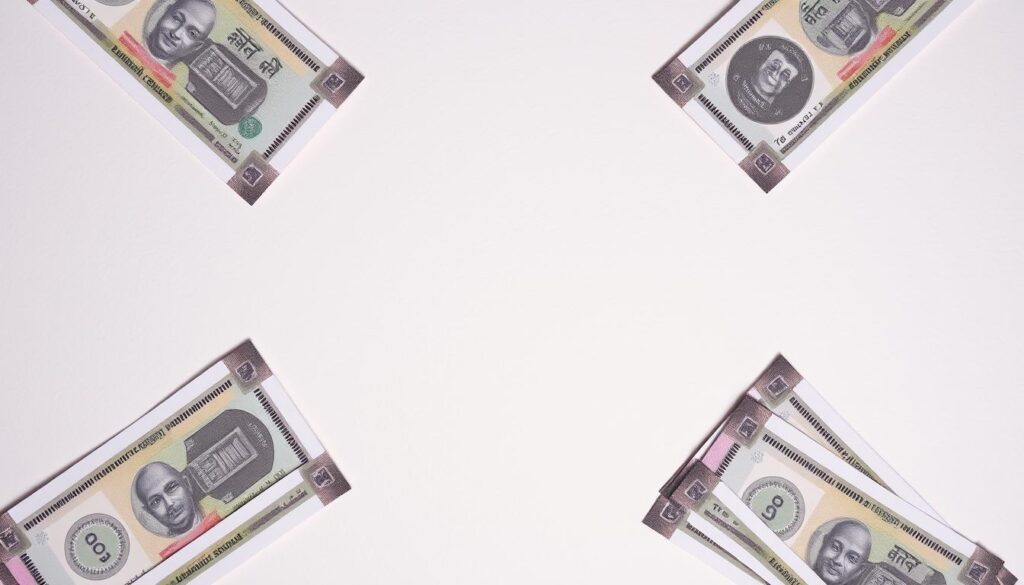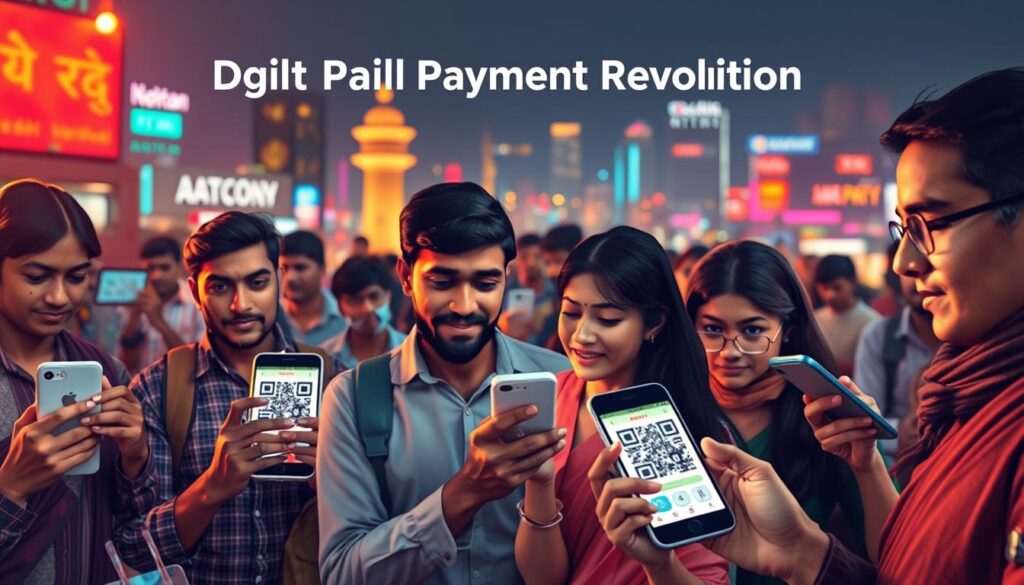
The Indian Rupee (₹, INR) is the official currency of India. It plays a key role in the country’s economy. The rupee has a long history, dating back to the 6th century BC.
The Reserve Bank of India (RBI) manages the Indian Rupee. Knowing about the rupee is important for those who want to do business in India.
Key Takeaways
- The Indian Rupee (₹, INR) is the official currency of India.
- The Reserve Bank of India (RBI) regulates the Indian Rupee.
- The rupee is divided into 100 paise, but paise are not used much anymore.
- Understanding the Indian Rupee is essential for businesses and individuals engaging with India.
- The Indian Rupee has a rich history and has evolved over time.
The Indian Rupee: India’s Official Currency
The Indian Rupee is key to India’s economy. It’s used for all money dealings in the country. This makes it a vital part of India’s money system.
Overview of the Indian National Currency
The Indian Rupee, or INR, is the Indian national currency. It’s given out by the Reserve Bank of India (RBI). The INR breaks down into 100 paise, but paise are not used much anymore because of inflation.
The Rupee is a symbol of national pride. It’s used in all official dealings in India. Its worth changes based on things like inflation, foreign exchange rates, and the economy’s health.
The INR Symbol and Its Significance
The Indian Rupee symbol, ₹, was brought in in 2010. It’s made from the Devanagari consonant “र” (ra) and the Latin capital letter “R” without its vertical bar. This symbol stands for India’s economy worldwide.
The INR symbol is important. It shows India’s cultural and economic tie to the world. It’s seen on money, coins, and in digital deals, making it a big part of India’s finance scene.
Having the INR currency symbol has made the Indian Rupee more known globally. It also helps show the strength of India’s economy.
History and Evolution of the Indian Rupee
The Indian rupee has a long and interesting history. It started with ancient punch-marked coins and has evolved into the modern currency we know today. This journey shows India’s rich culture and its ability to change with the times.
Ancient Origins of Indian Currency
The first Indian currency was used in the Mahajanapadas period, around the 6th century BCE. Silver punch-marked coins were the first money. These coins had symbols punched into them to prove they were real.
These coins started India’s monetary system. They helped trade and commerce grow across the region.
Colonial Period and Monetary Changes
The British East India Company changed India’s money system when they arrived. They brought standardized currency to make trade easier. The rupee became the main currency.
The British government made the currency even more standardized. They introduced new coins and banknotes. This modernized India’s money system.
Post-Independence Currency Development
After India became independent in 1947, the rupee stayed as the official currency. The Reserve Bank of India (RBI), started in 1935, managed the currency. It controlled how much money was out there and kept its value.
After independence, India added new money types and security features. This was to fight against fake money and keep the currency safe.
The story of the Indian rupee shows India’s economic and political growth. Knowing this history helps us understand India’s money system and currency today.
What Currency Is Used in India Today: Denominations and Forms
The Reserve Bank of India issues currency in many denominations. This makes transactions smooth. The Indian Rupee comes in banknotes and coins, meeting different financial needs.
Banknotes in Circulation
The Reserve Bank of India prints banknotes in several sizes. These include ₹10, ₹20, ₹50, ₹100, ₹200, ₹500, and ₹2000. Each has its own design and security features.
Current Banknote Denominations:
| Denomination | Key Features |
|---|---|
| ₹10 | Features an image of the Sun Temple |
| ₹20 | Depicts the Ellora Caves |
| ₹50 | Showcases the Hampi temple |
| ₹100 | Features a motif of the Rani Ki Vav stepwell |
| ₹200 | Depicts the Sanchi Stupa |
| ₹500 | Features the Red Fort |
| ₹2000 | Showcases the Mangalyaan, India’s Mars Orbiter Mission |
Coins and Their Specifications
India’s currency also includes coins in different sizes. The Reserve Bank of India issues coins in ₹1, ₹2, ₹5, ₹10, and ₹20 denominations.
Specifications of Indian Coins:
| Denomination | Material | Shape |
|---|---|---|
| ₹1 | Stainless Steel | Circular |
| ₹2 | Stainless Steel | Circular |
| ₹5 | Nickel-Brass | Twelve-edged |
| ₹10 | Bimetallic | Circular |
| ₹20 | Bimetallic | Circular with a distinctive shape |
Knowing about the Indian Rupee’s different forms is key for financial dealings in India. The variety in banknotes and coins helps with all kinds of transactions, big and small.
Design Features and Security Elements of Indian Currency
The Indian Rupee, India’s official currency, has a special design. It combines cultural heritage with advanced security features. This mix makes the currency both beautiful and trustworthy.
Visual Elements and Cultural Symbolism
Indian currency shows off the country’s rich culture. Banknotes have motifs and symbols important to India’s history and identity. For example, the ₹500 note has a picture of Mahatma Gandhi and the Red Fort. These symbols represent India’s fight for freedom and its cultural heritage.
The designs on Indian currency celebrate the nation’s diversity and heritage. They include various languages, like Hindi and English. This shows India’s linguistic variety.
Anti-Counterfeiting Measures
Indian currency has many security features to stop counterfeiting. These include watermarks, holograms, and microprinting. These are hard to copy.
The security features of the Indian Rupee are listed in the table below:
| Security Feature | Description |
|---|---|
| Watermark | A translucent image embedded in the paper, visible when held against light. |
| Hologram | A three-dimensional image that appears to move when the note is tilted. |
| Microprinting | Extremely small text that is difficult to read with the naked eye. |
The Reserve Bank of India updates these anti-counterfeiting measures often. This keeps the currency safe from fake money.
The mix of cultural symbols and advanced security makes the Indian Rupee unique and safe.
The Reserve Bank of India and Currency Management
The Reserve Bank of India (RBI) is in charge of managing India’s currency. It issues, regulates, and implements monetary policies for the currency.
Currency Regulation by RBI
The RBI controls the money in the economy. It keeps the currency stable and implements policies. The RBI’s role keeps the financial system stable and secure.
The RBI issues new currency and takes old currency out of circulation. This is key for the economy’s health.
“The stability of the currency is a critical factor in the overall economic health of a nation.” –
Demonetization and Currency Reforms
Demonetization was a big event in India’s currency history. The RBI and government did it to fight black money and boost digital payments. Demonetization changed how people do transactions in India.
| Year | Event | Impact |
|---|---|---|
| 2016 | Demonetization | Withdrawal of ₹500 and ₹1000 notes |
| 2017 | New Currency Issuance | Introduction of new ₹500 and ₹2000 notes |
| 2018 | Currency in Circulation | Increase in digital transactions |
The RBI keeps working hard to manage the currency and face new challenges. It aims to keep the financial system stable and help the economy grow.
Exchange Rates and Converting Currency in India

The Indian Rupee’s value changes often compared to other major currencies. It’s important to keep up with the latest exchange rates. This change affects both travelers and businesses that trade with India.
INR to USD and Other Major Currencies
The exchange rate between the Indian Rupee (INR) and the US Dollar (USD) is watched closely. Knowing this rate is key for:
- Travelers to and from India
- Businesses importing or exporting goods
- Investors interested in the Indian market
The INR is also exchanged against the Euro, Pound Sterling, and Japanese Yen. Economic factors like inflation, interest rates, and trade balances affect these rates.
Where to Exchange Currency in India
Visitors to India can exchange their money at several places:
- Authorized Currency Exchange Dealers: These dealers are licensed by the Reserve Bank of India (RBI) and offer good rates.
- Banks: Most banks in India exchange currency, often with better rates for their customers.
- ATMs: ATMs are a convenient way to get INR with international cards. But watch out for fees and charges.
Tips for Getting the Best Exchange Rates
To get the best exchange rates, follow these tips:
- Compare Rates: Look at rates from different places before you exchange money.
- Avoid Airports: Airport currency exchange counters usually have worse rates.
- Use Online Services: Online currency exchange services might offer better rates than physical places.
- Be Aware of Fees: Know any extra fees for exchanging currency or using ATMs.
By keeping up with exchange rates and knowing where to exchange currency, you can save money in India.
Using Money in India: A Practical Guide for Travelers
Traveling to India means knowing how to handle your money. You’ll need to understand the local currency and payment options. This knowledge will make your trip better.
Cash vs. Cards in India
In India, cash is still king, but cards and digital payments are gaining ground, especially in cities. Credit and debit cards work well in big cities and tourist spots. But, it’s smart to carry cash too, for small buys or rural trips.
Hotels and restaurants in India take Visa, Mastercard, and American Express. Still, having some Indian Rupees (INR) is wise, as not all places accept cards.
ATMs and Banking Services
ATMs are common in India, making it easy to get cash. Most accept international cards, and some banks have foreign card-friendly ATMs with low fees. Tell your bank you’re traveling to avoid any issues.
Banks in India offer currency exchange, ATMs, and more for travelers.
Regional Variations in Currency Usage
India’s diverse regions have different money habits. Cities like Delhi, Mumbai, and Bangalore have modern payment options. But, rural areas mostly use cash.
Travelers should adjust their payment methods based on the area. In rural spots, more cash is needed since digital payments are scarce.
Knowing these differences and carrying both cash and cards helps you manage money in India.
Digital Payment Revolution in India

A digital payment revolution is happening in India. It’s driven by new tech and changing how people shop. Now, making payments is quicker, safer, and easier.
Unified Payments Interface (UPI) and Mobile Payment Systems
The Unified Payments Interface (UPI) has changed India’s digital payments. It lets users send money instantly between bank accounts using a mobile app. This has made sending money and paying bills much simpler.
Key Features of UPI:
- Instant money transfer
- 24/7 availability
- Simple and secure
- Interoperability across different banks
E-wallets and Digital Banking
E-wallets and digital banking are getting more popular. They let users store money digitally and make payments online or through apps. Their ease and security have drawn many users, boosting the digital payment trend.
Benefits of E-wallets and Digital Banking:
- Convenience of managing finances digitally
- Enhanced security features
- Rewards and cashback offers
- Easy tracking of expenses
The Future of Currency in India
The future of money in India looks digital. The government is pushing for a digital economy, and more people are using digital payments. This change is expected to make things more efficient, transparent, and accessible to everyone.
| Aspect | Current Status | Future Outlook |
|---|---|---|
| Digital Payments Adoption | Increasing rapidly | Expected to become mainstream |
| Role of UPI | Pivotal in digital transactions | Continued dominance |
| E-wallets and Digital Banking | Growing in popularity | Further expansion |
Conclusion: Understanding the Indian Rupee for Visitors and Businesses
Knowing about the Indian Rupee is key for visitors and businesses in India. The Rupee has a rich history and is complex. It’s important for those in India to understand it well for financial dealings.
Travelers should learn about the Rupee’s different values and forms. They also need to know the current exchange rates. Businesses in India must understand the Rupee’s design and security to prevent fraud and ensure smooth transactions.
Digital payments are becoming more common in India. It’s important to know about the digital side of the Rupee. The Reserve Bank of India’s role and the effects of demonetization and reforms are also crucial to understand.
By learning about the Indian Rupee, visitors and businesses can make better choices. Whether exchanging money, using ATMs, or making digital payments, knowing the Rupee well is essential for a good experience in India.
FAQ
What is the official currency of India?
The official currency of India is the Indian Rupee. It is denoted by the symbol ₹ and coded as INR.
Who is responsible for issuing and regulating the Indian Rupee?
The Reserve Bank of India (RBI) issues and regulates the Indian Rupee.
What is the significance of the Indian Rupee symbol ₹?
The ₹ symbol represents India’s economy worldwide. It shows India’s cultural and economic connection to the world.
What are the available denominations of Indian banknotes?
Indian banknotes range from ₹10 to ₹2000.
What are the available denominations of Indian coins?
Indian coins are minted from ₹1 to ₹20.
How can visitors exchange their currency in India?
Visitors can exchange currency at authorized dealers, banks, or ATMs.
What is the current trend in payment methods in India?
Cash is still popular, but cards and digital payments are growing. This is especially true in cities.
What is driving the digital payment revolution in India?
The government’s push for a digital economy and smartphone growth are key. They drive the digital payment revolution in India.
What is UPI, and how is it used in India?
UPI is a mobile payment system for digital transactions. It’s gaining popularity in India.
How can one get the best exchange rates when exchanging currency in India?
To get the best rates, know the current rates. Avoid bad rates or high fees.

Adam G
This post was created by Adam G, a seasoned financial writer with a passion for explaining currency exchange and market movements
